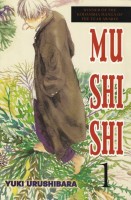 Creator: Yuki Urushibara
Creator: Yuki Urushibara
U.S. publisher: Del Rey
ISBN: 9780345496218
Released: January 2007
Original release: 2000
Awards: Japan Media Arts Award, Kodansha Manga Award
I no longer remember what first led me to pick up Yuki Urushibara’s debut manga Mushishi. It was probably mostly coincidence: the series started being released in English around the same time I started to really get into manga and was trying all sorts of things. I’m grateful for whatever reason it was that convinced me to read Mushishi because it became one of my favorite manga series. I love its quiet creepiness and beautiful storytelling. Mushishi was well-received both in Japan and abroad by both fans and critics. Among other recognitions and honors, Mushishi has earned a Japan Media Arts Award as well as a Kodansha Manga Award. Mushishi, Volume 1 was originally published in Japan in 2000. The English-language edition was initially released by Del Rey Manga in 2007 and, sadly, has since gone out of print. Happily, in 2014, Kodansha Comics released a digital edition of Mushishi in English.
Mushi—a category of primordial beings fundamental to the living world which may take on many forms. Truly understood by very few people, they are studied by mushishi, or mushi masters. Ginko is one such mushishi, making his living by traveling across the Japanese countryside, learning all that he can about mushi, and attempting to help those unfortunate enough to have come under the creatures’ influence. Mushi are often to blame for unusual natural phenomena and strange, otherwise unexplainable illnesses. Ginko is an expert, but even he is faced with circumstances beyond his knowledge and control; where mushi are involved, nothing is ever entirely certain. Sometimes the harm caused by the mushi has already been done and is irreversible, leaving humans to deal with the aftermath. They must learn to coexist or else risk their lives or sanity.
Although there is some continuity between the stories, Mushishi is largely episodic and each chapter in the first volume of the series stands well on its own. “The Green Gathering” introduces the concept of mushi while Ginko investigates a young man with the power to grant life to the things he draws. In “The Soft Horns” Ginko aids the residents of a snowbound village suffering from a peculiar kind of hearing loss. Mushi have invaded the dreams of a man in “The Pillow Path” with devastating and dire consequences. Urushibara’s award-winning “The Light in the Eyelids” was actually the very first Mushishi manga. The story follows a young girl whose eyes have become so painfully sensitive to light that she has been blindfolded and shut away by her family in a dark storehouse. The final story in Mushishi, Volume 1 is “The Traveling Bog” in which a swamp disappears and then reappears again and again, drawing ever closer to the sea each time.
Urushibara was influenced tremendously by older Japanese folk stories, but in developing Mushishi she draws on that inspiration to create a world and mythology of her own. Although the tales in Mushishi, Volume 1 are new, they still have a very familiar, traditional feeling to them that I find immensely appealing. I also enjoy the subtle horror present in many of the stories in Mushishi. While occasionally the manga and its imagery is disconcerting or even disturbing, Mushishi isn’t overly graphic or violent. Instead its creepiness derives from the fear of the unknown or the unknowable and the close intertwining of life and death. Mushi do not always bring misfortune, they can also be a benevolent force, but they are something beyond the understanding and power of most humans, and that can be frightening. In Mushishi, Volume 1 Ginko is shown trying to bridge the gap that exists between mushi and humans, but he often struggles to find the perfect balance between sharing his knowledge and protecting life.

Speak Your Mind